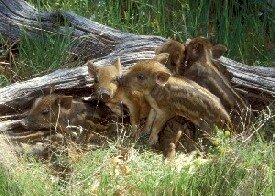Be a Pig
One question I often get is “What does a person need to do to recognize and describe all those flavors and aromas in wines?” I usually reply that it takes a lot of dedicated, hard work that involves tasting as many wines as you can get in your glass. I’m inclined these days to also say “Try being a pig”, but that probably needs an explanation:

I was driving along recently and saw a group of wild pigs rooting around quite enthusiastically next to the road. I pulled over to watch because it seemed that they were really enjoying what they were finding there. It was a group of what seemed to be 5-6 females or young males with about the same amount of yearling pigs. They were all different shades of brown — from copper to coffee colors (the piglets had stripes) — and they were oblivious to anything else happening around them. I rolled down the window and every one of them seemed to be grunting quite happily.
Pigs as we all know get a bad rap, most often in our language (Don’t be a pig, chauvinist pig, My, but you look like a pig). Around here, wild pigs have a bad reputation because they aren’t native, they tear up the ground when rooting around, they cause traffic accidents, there are too many of them, etc. (for an even-handed account of the controversy from someone who is experienced with the subject, click on this link: www.coestatepark.com/wild_pig.htm)
But while I sat in my car watching them that day, I was reminded of something that I really appreciate and can relate to: they are connoisseurs in their own right, especially when it comes to food. They eat acorns, berries, wild mushrooms, plant shoots, grubs, and, yes, given the opportunity, wine grapes at their ripest and most tastiest. (At one vineyard I worked for, it almost seemed pointless after awhile to go out and see if the grapes were ready to harvest, because if they were, the pigs usually got there first!)
Now, when I have some time away from the winery, I like to go out on hikes and, if the season is right, look for mushrooms. Being a mushroom seeker, and moreso because I’m a novice, often means inthe dirtiest, muddiest sense, being, truly, a pig –rooting around in the dirt, under rotting leaves, going through underbrush and poison oak to find interesting, and possibly tasty specimens. While I’m doing this, though, I like to think that I’m experiencing what a pig might experience, being the connessieur he is: a pure, unabashed assault of the senses by the natural world. Earthy, barnyard, dung, cedar, oak, moldy, musty, herbal, damp, spicy, minty. (Do those descriptors remind you of anything? Winespeak, maybe?) Then, if I actually find a mushroom or two, it gets even better because the mycological realm presents it’s own incredible array of aromas and flavors. Some mushrooms smell like almond extract (the Prince, Almond agaricus). Oyster mushrooms fresh off a tree smell like anise. There are other mushrooms that smell fragrantly spicy (cauliflower mushrooms), or of apricots (chantrelles). Some poisonous mushrooms smell fishy or farinaceous, or like maraschino cherries or library paste. A whole sensory education in the outdoors! What more could a hedonist or a pig or a wine lover ask for?
So, it’s pretty simple: to get nearly a complete sensory education, all you have to do is be a pig, or, at the very least, take a hike! Happy Rooting
he-don-ism, n: Pursuit of or devotion to pleasure, especially to the pleasures of the senses

March 18th, 2006 at 1:59 am
Here at Lisson, we decided long ago, that wild boars have a “mustimètre” (instrument to measure the ripeness of grapes) incorporated in their noses. They would not touch an underripe Mourvèdre and they exactly know that Pinot Noir and Merlot are “ready” earlier than Cabernet. And when we consider, it’s the best moment to harvest, it normally corresponds to their choice – and they are night-workers…
I read your links with much interest “We can learn to live with pigs, for we may have to. Sooner or later the pigs will become a regular part of the diet of native predators and will level out at a lower population.” I liked this one – so we just have to wait for mountain lions and coyotes around here in the South of France:-)))
But seriously: I learned to trust the judgement of my taste and nose, like the pigs must do, to decide when a grape is perfect for wine – and many winemakers will tell you the same, you can also judge from the texture and taste of the seeds, whether it’s the right moment.
Well, I should go back to pruning in the wines – but there are conditions, when I ask myself, if a winemaker is really a hedonist…
March 18th, 2006 at 10:05 am
Hi Iris, Your experiences with wild pigs are very interesting. What interests me, also, is that we complain about them so much here, but as you point out, at least we have some predators that will help control them, whereas the control in France probably only comes out of the end of a shotgun (I wonder how many different recipes there are in France for cooking un sanglier). No, being a winemaker does not afford time or energy always to hedonist ways….I think pruning and bottling in particular could almost be consider masochistic!